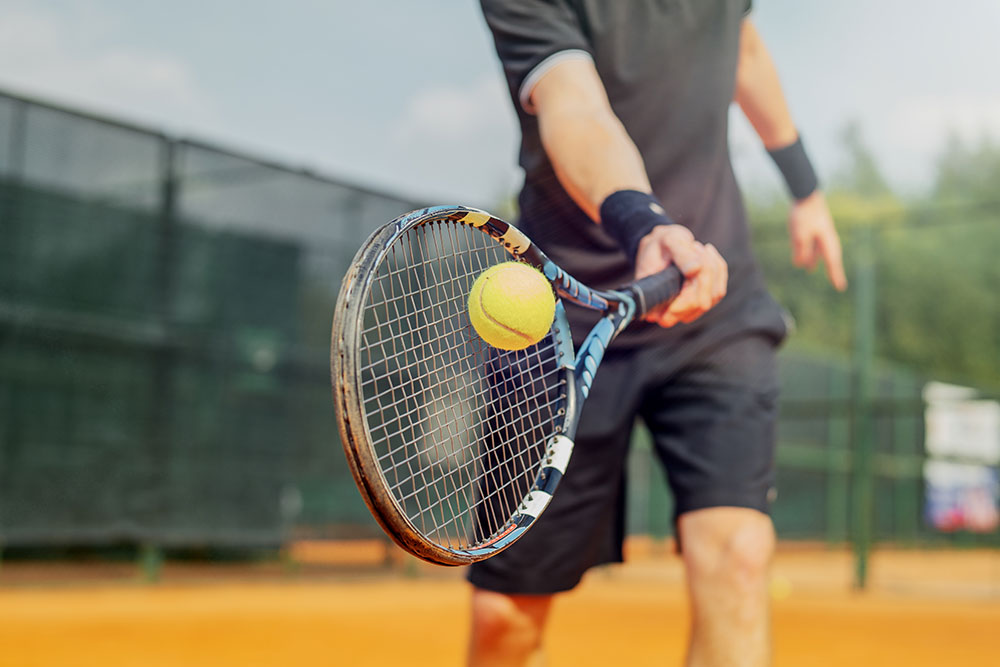
The sport of tennis saw a significant increase in new players in the United States in 2021. Common tennis injuries involve the knee and shoulder. Richard Cunningham, MD, is a Board Certified Orthopedic Surgeon specializing in sports injuries of the knee and shoulder. Dr. Cunningham wants to help educate tennis players on common knee and shoulder tennis injuries and conditions.
Knee Injury in Tennis Players
Tennis players exert significant demands on the knee. Rapid starting and stopping motions, pivoting, cutting, and rotating stress the knee. Below are common tennis knee injuries and how they can be prevented.
Patellar tendonitis – The patella tendon connects the shin bone (tibia) to the kneecap (patella). Patellar tendonitis is an inflammation of the tendon and consists of the following symptoms:
- Mild to severe anterior knee pain
- Tender to the touch
- Swelling over the tendon
- Stiffness of knee
- Pain with knee flexion or kneeling
To avoid complications, tennis players should seek medical attention if they are experiencing the above symptoms and there is not improvement over time. Treatment ranges from RICE (rest, ice, compression, and elevation), non-steroidal anti-inflammatory medications, a patellar tendon strap (Chopat strap), and physical therapy.
Prevention begins with:
- Proper footwear for court play
- Warm up and stretch before and after play
- Maintain good strength in the hamstrings and the gluteal muscles which tend to be weaker compared to quadriceps and hip flexor strength in tennis players
- Pace your game, and take breaks when needed
- Cross train
Alternating high-impact with low-impact activity helps promote knee joint health and longevity.
Ligament Tear – Tennis players can suffer knee ligament tears due to sudden decelerations or a twisting fall. One can tear the anterior cruciate (ACL) and/or medial collateral (MCL) most commonly but in some cases they may tear the posterior cruciate (PCL) and/or lateral collateral (LCL),. A sudden ligament tear typically causes the following symptoms:
- Popping sound
- Severe and sudden pain
- Immediate Swelling
- Instability and looseness in knee
- Pain with weightbearing
This is an acute injury requiring urgent care. It is best to see an Orthopedic Surgeon specializing in Sports Medicine. This physician would take a history, do a physical exam, and obtain imaging such as Xrays and possibly an MRI. Not all ligament tears require surgery, but some do in order to make the knee stable so that you can return to sports.
Prevention of ligament tears involves common sense precautions:
- Stretch and strengthen all the muscles that support and stabilize the knee
- Do warm-up activities prior to play
- Increase intensity slowly
Shoulder Injury in Tennis Players
Overhead motion, overuse and muscle weakness contributes to shoulder injury in tennis players. Irritation and inflammation can lead to pain. Dr. Cunningham treats tennis players with these common shoulder injuries and shares how to prevent them.
Tendon Inflammation and Bursitis – Overuse injuries of the shoulder can aggravate and inflame the shoulder causing pain. There are two common types of inflammation in the shoulder:
- Bursitis of the shoulder – within the shoulder complex there is a fluid filled sac that acts as cushion between the rotator cuff tendon and the overlying bone. Inflammation and irritation of the bursa can cause pain severe enough to prevent play.
- Shoulder tendonitis – Just as the bursa is subject to overuse and irritation, the rotator cuff tendons can become inflamed. This painful condition is called impingement syndrome or shoulder tendonitis.
With shoulder bursitis or shoulder tendonitis, tennis players will notice these symptoms:
- Pain with overhead motions
- Night pain when lying on injured side
- Pain when reaching out to the side
Prevention of shoulder inflammation include:
- Reduce overhead and repetitive shoulder activity
- Stretch and strengthen rotator cuff muscles
- Analyze and improve tennis technique
- Alternate low impact activity
- Warm-up prior to play
Rotator Cuff Tear – The repetitive overhead motions associated with tennis can lead to wear and tear of the tendons over time resulting in tears to slowly develop. Rotator cuff tearing commonly causes the following symptoms:
- Pain at night which interrupts sleep
- Popping in the shoulder
- Weakness in the shoulder
- Pain with overhead activities
Low grade partial thickness tearing of the rotator cuff tendons are usually treated with RICE, pain and inflammation management, prescribed strengthening and stretching exercises, and injection therapies. However, if there is a full rotator cuff tendon tear, then active and healthy patients often come to arthroscopic rotator cuff repair surgery to alleviate the pain and restore strength and the ability to resume tennis.
Dr. Cunningham is committed to keeping tennis players in the game. If you have questions about a tennis injury, contact Dr. Cunningham today. Vail, CO office at (970) 476-2451, Edwards CO office at (970)-569-3240 or in Frisco, CO office at (970) 668-3633.
